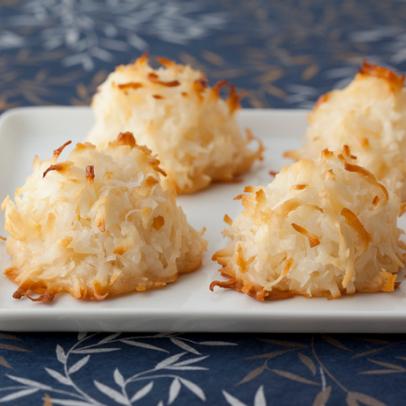These French macarons make a very special treat to give your friends and family. They also look pretty on a plate for guests to indulge in when they come over. They can definitely be finicky but once you learn how to make macarons you’ll be hooked!
Even if your macaron cookies come out of the oven looking totally wrong they’ll still be delicious if not picture perfect. If you have extra almond flour then try my homemade almond cookies!
Egg Whites- Make sure the weigh them using a kitchen scale. Aging egg whites for macarons is an important step. Separate the eggs, place the whites in a clean glass, cover with plastic wrap with a few holes poked in and let them hang out in the fridge for a few days before using. This will dehydrate them and make them perfect for macarons. This step isn’t a must do but a bunch of little things can add up to a big difference when making these cookies.
Almond Flour- Almost all brands will say “super-fine” but you will still need to sieve and process them to be even finer, so don’t stress out at the market it will all work out.
:max_bytes(150000):strip_icc()/easy-macaron-recipe-435221-hero-01-b3680f676df64f5ab2c1e65976c0e945.jpg)
French Macarons

Review this page, video, troubleshooting, and success tips and follow the recipe precisely for crisp, chewy, delicate French macaron cookies. Have fun with fillings! I provide some filling ideas in the recipe notes. We strongly recommend using gram measurements, but see recipe note if you do not have a kitchen scale.
Prep: 1h
Total: 1h30min
Yield: 40
Ingredients:
- 100 g egg whites (usually between 3-4 large egg whites)
- 1/4 teaspoon (1g) cream of tartar
- 1/2 teaspoon extract such as vanilla, almond, coconut, etc (optional)
- 80g superfine sugar (aka caster sugar, see note)
- 1-2 drops gel food coloring (optional)
- 125g almond flour
- 125g confectioners’ sugar
- desired macaron filling (some options listed in notes)
Instruction:
- Wipe down a large glass or metal mixing bowl with lemon juice or vinegar. Add egg whites. Cover and refrigerate for 24 hours, then bring to room temperature.
- Line 3 large baking sheets with silicone baking mats or parchment paper. Set aside.
- Add cream of tartar and extract (if using) to egg whites. Using a handheld mixer or stand mixer fitted with a whisk attachment, beat together on medium speed until very soft peaks form. This takes a few minutes of beating. At first the egg white and cream of tartar mixture will be foamy, then the bubbles will begin to tighten and the beaters will leave tracks as the egg whites build volume. Once they begin leaving tracks, you likely have soft peaks. Stop beating. Add about 1/3 of the superfine sugar. Beat on medium-high speed for 5 seconds, then with the mixer continuing to run, add another 1/3 of the sugar. Beat for 5 seconds, then with the mixer continuing to run, add the remaining sugar. Beat on medium-high speed until stiff glossy peaks form. (This means the whites have stiff, smooth, and sharp points in the bowl or on the lifted whisk attachment/beaters. Stiff peaks do not droop down. You can turn the bowl upside down and the egg whites will not move or spill out.) Using a rubber spatula, slowly and gently fold the food coloring (if using) into the egg whites.
- Sift the almond flour and confectioners’ sugar together in a large glass or metal mixing bowl. Use a spoon to help work any larger pieces through the sieve. You don’t want to discard a lot of that because then you won’t have enough dry ingredients in the batter.
- Slowly fold the beaten egg whites into the almond flour mixture in 3 separate additions, folding until combined before adding the next addition. After you add all of the egg whites, pay very close attention to the consistency of your macaron batter. Continue folding the batter (which deflates air) until it thins out into the consistency of honey. What’s a more helpful cue is the figure 8 test. Drop the macaron batter off of your spatula in the form of a figure 8. The figure 8 should take no more than 10 seconds to sink back into itself. If it takes less, your batter was overmixed and is too thin. If it takes longer, continue slowly folding the batter to deflate more air, then perform the figure 8 test again. It’s best to go very slow so you don’t accidentally overmix.
- Spoon the macaron batter into a piping bag fitted with a medium round piping tip, such as Wilton 12, Wilton 1A, or even Ateco 806. The macaron batter is very drippy, so transferring to the piping bag can be messy.
- Holding the piping bag at a 90 degree angle over the baking sheet, pipe batter in 1.5 – 2 inch rounds about 1-2 inches apart on prepared baking sheets. I usually pipe little mounds—see video tutorial above. The piped macaron batter flattens out. Bang the pan a couple times on the counter to pop any air bubbles, then use a toothpick to pop any remaining air bubbles.
- Let the piped macarons sit out until they are dry and no longer tacky on top, usually 30-60 minutes. This time allows the top to firm up and form a skin, which helps the macarons rise UP and form their trademark ruffly “feet.” Do not let them sit out for longer than they need to because they could begin to deflate.
- Meanwhile, preheat the oven to 325°F (163°C).
- Bake for 13 minutes. As the macaron shells bake, they should form feet. To test for doneness, lightly touch the top of a macaron with a spoon or your finger (careful, it’s hot). If the macaron seems wobbly, it’s not done and needs another 1-2 minutes. If it seems set, it’s done. Basically, bake until the macarons don’t move around when touched.
- Let the shells cool on the baking sheet for 15 minutes, then transfer to a cooling rack to continue cooling. The macaron shells may stick to the parchment paper/baking sheet if you try to remove them too early. If this is happening, let them cool on the baking sheet a little longer before removing.
- After cooling, the shells are ready to fill and sandwich together. I have plenty of filling suggestions in the recipe notes below. You can spread filling with a knife or pipe it using the same round tip you used for the macaron batter.
- You can eat right away or, as some professionals prefer, cover and refrigerate them 12-24 hours so the macarons and flavors can mature. Bring to room temperature before serving. (I usually just serve them right away!)
- Cover leftover macarons and refrigerate for up to 5 days.
Coconut Macaroons

Prep: 0 10min0
Total: 0 35min0
Yield: 20 to 22 cookies
Serving Size: 1 of 21 servings
Nutrition Facts: servingSize 1 of 21 servings, calories 158, Fat 8g, Saturated Fat 7g, Carbohydrate 19g, Fiber 1g, Sugar 18g, Protein 2g, Cholesterol 6mg, Sodium 97mg
Ingredients:
- 14 ounces sweetened shredded coconut
- 14 ounces sweetened condensed milk
- 1 teaspoon pure vanilla extract
- 2 extra-large egg whites, at room temperature
- 1/4 teaspoon kosher salt
Instruction:
- Preheat the oven to 325 degrees F. Combine the coconut, condensed milk, and vanilla in a large bowl. Whip the egg whites and salt on high speed in the bowl of an electric mixer fitted with the whisk attachment until they make medium-firm peaks. Carefully fold the egg whites into the coconut mixture. Drop the batter onto sheet pans lined with parchment paper using either a 1 3/4-inch diameter ice cream scoop, or 2 teaspoons. Bake for 25 to 30 minutes, until golden brown. Cool and serve.
Macaron recipe

These elegant, delicate, and delicious french macarons are the perfect treat for your next get together!
Prep: 15min
Total: 40min
Yield: 36
Serving Size: 11 g
Nutrition Facts: servingSize 11 g, calories 63 kcal, Carbohydrate 6 g, Protein 0.8 g, Fat 1.9 g, Saturated Fat 0.7 g, Cholesterol 0.7 mg, Sodium 18 mg, Fiber 0.5 g, Sugar 5.2 g
Ingredients:
- 100 g egg whites (room temperature 3 large eggs)
- 140 g almond flour (1 1/2 cups)
- 90 g granulated sugar (just under 1/2 cup)
- 130 g powdered sugar (1 cup)
- 1 tsp vanilla (5mL)
- 1/4 tsp cream of tartar (800mg)
- 1 cup unsalted butter softened (226g)
- 5 egg yolks
- 1/2 cup granulated sugar (100g)
- 1 tsp vanilla
- 3 tbsp water (30mL)
- 1 pinch salt
Instruction:
- Bake at 300F for 12-15 minutes, rotate tray after 7 minutes. Allow to cool completely before removing from baking sheet.
- Add in butter one cube at a time allowing each piece to incorporate before adding the next. Add vanilla and salt. Continue mixing until buttercream is smooth and creamy. (About 5-6 minutes.) Add food coloring if desired.
- Pipe your filling onto the back of half the shells. Form a sandwich and repeat. Macarons should be aged in the fridge for 1-3 days for best results. This allows the filling to soften the shells inside.
